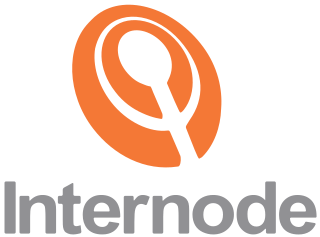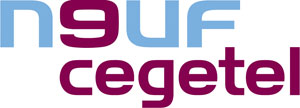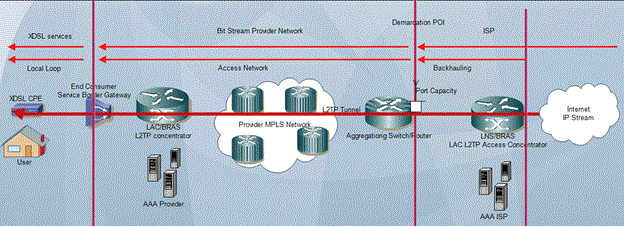Local loop unbundling is the regulatory process of allowing multiple telecommunications operators to use connections from the telephone exchange to the customer's premises. The physical wire connection between the local exchange and the customer is known as a "local loop", and is owned by the incumbent local exchange carrier. To increase competition, other providers are granted unbundled access.
Digital subscriber line is a family of technologies that are used to transmit digital data over telephone lines. In telecommunications marketing, the term DSL is widely understood to mean asymmetric digital subscriber line (ADSL), the most commonly installed DSL technology, for Internet access.

A digital subscriber line access multiplexer is a network device, often located in telephone exchanges, that connects multiple customer digital subscriber line (DSL) interfaces to a high-speed digital communications channel using multiplexing techniques.

Internode Pty Ltd is an Australian Internet service provider (ISP) that provides ADSL and NBN broadband Internet access, business-class access, web hosting, co-location, Voice over IP, and a variety of related services.
Telkom SA SOC Limited is a South African wireline and wireless telecommunications provider, operating in more than 38 countries across the African continent. Telkom is a semi-privatised, 39% state-owned enterprise.

Internet Protocol television (IPTV) is the delivery of television content over Internet Protocol (IP) networks. This is in contrast to delivery through traditional terrestrial, satellite, and cable television formats. Unlike downloaded media, IPTV offers the ability to stream the source media continuously. As a result, a client media player can begin playing the content almost immediately. This is known as streaming media.
A naked DSL, also known as standalone or dry loop DSL, is a digital subscriber line (DSL) without a PSTN service — or the associated dial tone. In other words, only a standalone DSL Internet service is provided on the local loop.
Covad Communications Group was an American provider of broadband voice and data communications. By Q3 2006, the company had 530,000 subscribers, and ranked 16th largest ISP in the United States. Covad was acquired by U.S. Venture Partners, who in 2010 announced a 3-way merger of MegaPath, Covad, and Speakeasy, creating a single Managed Services Local Exchange Carrier (MSLEC), providing voice and internet services; the new company was named MegaPath.

A broadband remote access server routes traffic to and from broadband remote access devices such as digital subscriber line access multiplexers (DSLAM) on an Internet service provider's (ISP) network. BRAS can also be referred to as a Broadband Network Gateway (BNG).
G.992.5 is an ITU-T standard for asymmetric digital subscriber line (ADSL) broadband Internet access. The standard has a maximum theoretical downstream sync speed of 24 Mbit/s. Utilizing G.992.5 Annex M upstream sync speeds of 3.3 Mbit/s can be achieved.
The 21st Century Network (21CN) programme is the data and voice network transformation project, under way since 2004, of the UK telecommunications company BT Group plc. It was intended to move BT's telephone network from the AXE/System X Public Switched Telephone Network (PSTN) to an Internet Protocol (IP) system. As well as switching over the PSTN, BT planned to deliver many additional services over their new data network, such as on-demand interactive TV services.

Be Unlimited was an Internet service provider in the United Kingdom between 2004 and 2014. Initially founded as an independent company by Boris Ivanovic and Dana Tobak in 2005, it was bought by Spanish group Telefónica Europe in 2006 before being sold on to BSkyB in March 2013 in an agreement which saw BSkyB buy the fixed telephone line and broadband business of Telefónica Europe which at the time traded under the O2 and BE brands. The deal saw BSkyB agree to pay £180 million initially, followed by a further £20 million after all customers had been transferred to Sky's existing business. The sale was subject to regulatory approval in April 2013, and was subsequently approved by the Office of Fair Trading on 16 May 2013.

Orcon Limited is a New Zealand telecommunications company. It is New Zealand's fourth largest Internet service provider (ISP). In 2013 it had a 5% share of the fixed line market.
In the telephony business, sub-loop unbundling (SLU) is a type of unbundled access whereby a sub-section of the local loop is unbundled. In practice this often means the competitor placing a small street cabinet with a DSLAM, next to a telco local copper aggregation cabinet or serving area interface and using a 'tie cable' to connect to the last part of the local loop into customers' homes. Lyddington in Rutland was the first example of SLU in the UK when local provider Rutland Telecom unbundled the cabinet to offer VDSL broadband.

Neuf Cegetel was a French wireline telecommunications service provider and a mobile virtual network operator (MVNO). It offered various telecommunications services to consumers, enterprises and wholesale customers, ranking second in the country in annual revenues. It was legally established in 2005 following the completion of the merger between Neuf Telecom and Cegetel. As of June 2008, the company became a wholly owned subsidiary of SFR, and the brand disappeared commercially.
Unbundled access is an often practiced form of regulation during liberalization, where new entrants of the market (challengers) are offered access to facilities of the incumbent that are hard to duplicate. Its applications are mostly found in network-oriented industries and often concerns the last mile.
Internet access is widely available in New Zealand, with 93% of New Zealanders having access to the internet as of January 2020. It first became accessible to university students in the country in 1989. As of June 2018, there are 1,867,000 broadband connections, of which 1,524,000 are residential and 361,000 are business or government.

Asymmetric digital subscriber line (ADSL) is a type of digital subscriber line (DSL) technology, a data communications technology that enables faster data transmission over copper telephone lines than a conventional voiceband modem can provide. ADSL differs from the less common symmetric digital subscriber line (SDSL). In ADSL, bandwidth and bit rate are said to be asymmetric, meaning greater toward the customer premises (downstream) than the reverse (upstream). Providers usually market ADSL as an Internet access service primarily for downloading content from the Internet, but not for serving content accessed by others.
Sonic is a telecommunications company and internet service provider based in Santa Rosa, California, acting as a competitive local exchange carrier in the San Francisco Bay Area, Sacramento, and Los Angeles.
Chorus is a provider of telecommunications infrastructure throughout New Zealand. It is listed on the NZX stock exchange and is in the NZX 50 Index. It is the owner of the majority of telephone lines and exchange equipment in New Zealand. It is also responsible for building approximately 70% of the new fibre optic Ultra-Fast Broadband network. It has received a government subsidy of $929 million to build the new fibre network.








